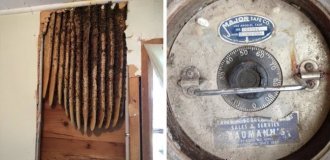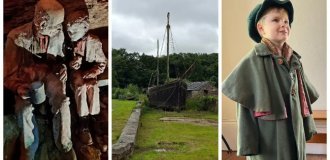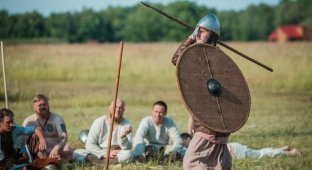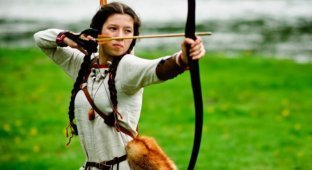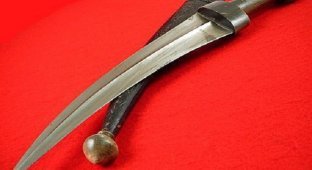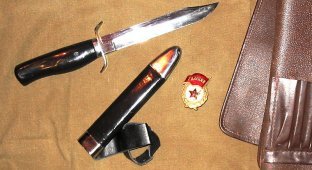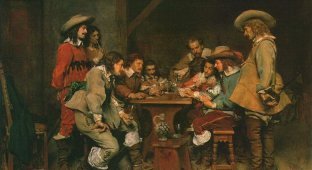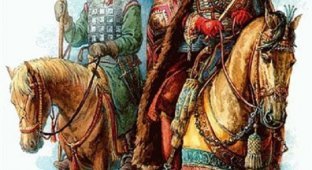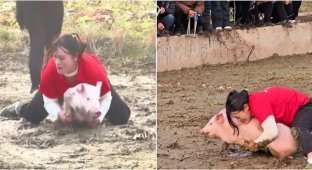I present to you a small selection of armor and weapons. More precisely, we’ve finished about armor, let’s move on to weapons. And let's start with the throwing one.
I warn the lazy people at once there are not just a lot of letters, but a lot. For aesthetes, I want to add - it has not been read or verified. So you are not welcome here.
The simplest - a simple bow - is a wooden stick bent into an arc, the ends of which are pulled together with a bowstring. The first step towards improving the bow was taken when bows began to be made not from one, but from two pieces of wood, joined in the middle at a certain slight angle and reinforced in certain places with linings of various materials. The strength of combat from such a bow depended on its size and the strength of the central part. This type of bow is called a compound or compound bow. But the most advanced bow created during the Middle Ages was the composite bow. Made from not one, but several types of wood. These bows, even with their smaller sizes, had significantly better fighting qualities. The composite bow was made from at least three different materials. Composite bows usually bend in the opposite direction to how they are when unstretched. And the most powerful bows were brought into firing position using special machines.

Onions first became widespread in Egypt. Here it was the most important weapon, widely used in war throughout Egyptian history. It is not surprising that throwing weapons, experience in handling which was easy to acquire while hunting, at first retained a leading role on the battlefield. The army of Ancient Egypt in the 3rd millennium BC consisted primarily of archers, slingers and boomerang throwers. The Egyptian pharaoh Tutankhamun was accompanied in his tomb by a whole collection of bows - 46 pieces! Being large in size (and Egyptian bows often exceeded 1.5 m), when using the appropriate types of wood, the simple bow of the Egyptians was a fairly powerful weapon.

At the same time, the “Scythian bow” appears in the north-west of Mesopotamia. Its appearance and spread is directly related to the cavalry of the pastoralists of the Eurasian steppes. This bow was small, sigma-shaped, up to 100 cm in size, which was due to the convenience of shooting from a horse.

Typically, horse archers used shorter bows, while foot soldiers used longer ones. But not always. The bows of horse nomads had a length of up to 180 cm. And in Japan, samurai used long asymmetrical bows - yumi, which, although simple, reached 2 meters in length. The upper part of such bows was long and elongated, the lower part was short and rounded.

Eastern bows of the same period were composite, wooden and horn. And they served as the basis for the creation of more complex and powerful composite bows. Chinese bows with their sigmoid shape, with a particularly large and particularly curved upper horn, which was equipped with a jade overlay, belong to the same type. These large (up to 140 cm long) and powerful bows, without any special changes, were made and used in China from the 1st millennium BC.
Composite bow turned forward, uncocked.

Composite bow. In or out of combat condition.

On the territory of Rus', a similar bow was known already in the 1st millennium BC. The materials for their manufacture were horn, boiled tendons of large animals and hard wood - juniper, birch, ash, oak. These blanks were glued together with fish scale glue and placed under a press. Then, for better preservation, the roughly collected onions were covered with birch bark, thin leather or parchment, and covered with varnish. The shape of a composite bow with a tight string resembles the letter M with smooth bends. This is exactly how ancient Russian bows are depicted on all monuments of art. Ancient artists depicted both warriors and hunters with composite bows. The firing range from such a bow reached 300 meters, when shooting from a horse it increased by 50-60 meters, the target firing range was about 100 meters. But such a bow was very expensive, and its production took at least two years from the moment the ax first bit into the tree to the moment when the warrior first cocked the bowstring.
Russian archer.

Simple bows were also used in Rus'. During archaeological excavations in Novgorod, Staraya Russa and other cities, many wooden simple bows up to a meter, and sometimes up to 130 cm in length, were found. Most often they were made from elastic juniper. They were often given the shape of composite bows. These were children's toy bows. A lot of them were found because learning archery began with children's games. Archery was a difficult task that required a lot of training.

The design and components of the ancient Russian composite bow, as well as the bows of the neighboring peoples of Eastern Europe, are now quite well understood from archaeological materials. The components of the ancient Russian bow, like those of the Arabs, Turks, Tatars and other eastern peoples, had special names. The middle of the bow was called the handle, the long elastic parts on either side of the handle were the horns or shoulders of the bow, and the ends with the cutouts for the bowstring loops were the ends. The side of the bow facing the target during shooting was called the back, and the side facing the shooter was called the inner side (or belly). The joints of individual parts (base with ends, handle plates with shoulders, etc.) were fastened with windings of tendon threads and called knots.

In Novgorod in 1953 in the layer of the second half of the 12th century. For the first time, a large fragment of an ancient Russian composite bow was found. The bow was glued together from two beautifully planed long strips of different types of wood (juniper and birch) and screw-shapedly covered with thin strips of birch bark to protect against dampness. The bow was charred at the handle, but its ends were not preserved. After lying in the ground for 800 years, the bow retained the ability to vibrate. The length of the preserved part of the bow is 79.5 cm, the width of the horn in the middle is 3.4 cm, and at the end it is 2.7 cm, the thickness is 1.8 cm. In section, the bow has the appearance of a flattened oval. The juniper bar was located on the inside of the bow, facing the shooter during shooting. Its length is 79.5 cm, width from 2.7 to 3.4 cm, thickness from 5 mm at the end of the bow to 9.5 mm in the middle of the shoulder. In cross section it looks like a segment. The inner surface of the plank is flat, it has three longitudinal grooves (1.5 mm wide and about 1 mm deep) for more durable gluing with a birch plank of a similar shape. The outer surface of the plank is rounded. Near the handle of the bow, it was burnt, and at the end of the bow that was not preserved, it has a slightly beveled cross section (end), to which the wooden end of the bow was adjacent. The birch plank had a similar shape, but it was worse preserved, in two fragments, one of which, closer to the bow handle, is still very firmly glued to the juniper plank. A birch strip was located along the back of the bow. The length of its two fragments is 58 cm, the width is from 2.3 cm, and at the handle up to 2.7 cm at the end, the thickness is 6 - 7 mm. There are no grooves for gluing on the inner flat surface of the birch strip. The outer surface of the plank is rough; there are traces of glue on it. In cross-section, the bar is also segment-shaped. The birch bark lining of the onion is well preserved. The length of the birch bark strips is about 30 cm, width 3.5 cm, thickness about 0.5 mm. During the helical gluing of the bow, the edge of the 8 mm wide birch bark tape was overlapped and overlapped with the next turn. This bow was reinforced with tendons that were glued to the back of the bow. But they were not preserved. The ends of the tendon threads were secured at the handle and at the ends of the bow. The elastic and very strong fish glue did not interfere with the contraction of the tendons when the bowstring was removed. Without a string, the ends of the composite bow were bent to the outside. Judging by the gap between the birch strip and the birch bark lining, the layer of sinew on this bow had a thickness of 2 to 3 mm. However, in Rus' from the 9th to the 14th centuries. bows that were more complex in design were also widespread. This is evidenced by numerous finds of sets of bone and horn overlays from the handles of composite bows. In Rus', bows were made that were suitable for use in any weather - in the heat, in the rain, and in the cold. Which, for example, neither the Landsknechts of the Crusaders nor the Horde could afford; their weapons could not fire due to frost or rain.

Bow strings were made from fibrous plants, silk threads, animal rawhide, and sometimes women's hair. A bowstring in the form of a thin rope, cord or twisted strap tightened the ends of the bow. The string was usually attached to the bow on one side, and the other had a loop, which was cocked before use. For storage, ease of carrying and to protect them from dampness and damage, bows were placed in special leather cases - bows, suspended from a belt or on a strap over the shoulder. Small arms were very afraid of dampness. Especially the bowstring. Therefore, the bow was always stored by removing the string from the valance, and always placing the bow in the bow. And they were brought into a combat position only immediately before use.



When archery, devices were widely used to protect the archer's hands from damage. These are gloves and shoulder pads, guards for the wrist of the left hand and bone (horn) rings for the index finger of the right hand. Trained archer warriors managed without these devices. Having placed the arrow on the string, the archer raised the bow, simultaneously drawing it, until the arrow reached the aiming line. Then he sent the arrow towards the target. Taking a position, the archer stuck several arrows into the ground around him, and in the future was completely dependent on the agility of the carriers. It was impossible to carry many long English arrows with you. Already two or three dozen of these shells began to look like a bundle of brushwood.

The country where the simple but long yew bow spread very widely was England. English archers were armed with a bow - longbow, the length of which was about 1.6 - 2 m, the length of the arrow was from 0.915 m to 1.5 m, the flight range of a light arrow was up to 210 m, of a heavy arrow up to 140 m, the sighting range was up to 90 m. Simple European bows were made from yew, ash, and elm. Sometimes bows were equipped with reinforcing linings made of flax, leather and sinew. The rate of fire of the bow was very high. English archers fired 10-12 arrows per minute, but the then famous Genoese crossbowmen fired only four arrows. In archery, 1 out of 4 wounds usually occurred in the head.

The strength of medieval simple bows was from 20 to 40 kg (the last figure corresponded to long English or Varangian bows) for simple ones, and up to 80 kg for composite ones. Only modern compound bows are more powerful than them. That is why archers who used simple bows pulled the string to the ear, and those who used composite bows to the chest. At the same time, each archer chose a bow according to his own strengths, as well as determined the length of the arrow according to his height and arm length.

Since the time of the Scythians and Cimmerians, the horse archer has shown himself to be a rather formidable combat unit. On the one hand, it was difficult for the rider to use a long and powerful bow. On the same section of the front, foot riflemen could fit several times more than mounted ones. And the horseman did not shoot as often and accurately as the foot archer. On the other hand, the horse allowed the archer to keep the enemy at a distance, stock up on arrows and quickly return to the convoy for more. Finally, a horse archer could be in the right place faster than a foot archer.

Usually, while firing at the infantry, the cavalry “spun the carousel.” The horseman raced along the infantry formation and fired several arrows from a distance of 5-50 meters. Then he turned around and made a new approach. But if the cavalry used powerful bows and heavy arrows, then another valuable opportunity opened up before them. The range of the shot could be increased by adding the speeds of the horse and the arrow. A slow, heavy arrow fired over the head of a galloping horse received additional acceleration and flew 30-40% further. This is how the Mongols acted: they accelerated and fired their long arrows from a distance of 250-300 meters. And then they managed to turn around before they were within the reach of enemy bows.



